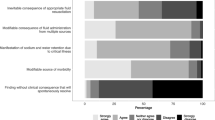Abstract
The recently published new guidelines for cardiopulmonary resuscitation were derived from an international "Consensus of Science", challenging many of the traditional rules. This may explain the extraordinary extent of changes compared to the earlier guidelines. The new rules for basic life support for adults emphasize the outstanding importance of compressions. In general the decisions regarding basic life support try to simplify procedures and are driven by the fact that starting effective basic measurements is the key for resuscitation success. The rules for advanced life support remained generally unchanged. In contract mild therapeutic hypothermia has been emphasized in the guidelines for post resuscitation care as one of the few major progresses improving prognosis.
Zusammenfassung
Die kürzlich publizierten neuen Leitlinien zur kardiopulmonalen Reanimation, die aus einem internationalen "Consensus of Science" abgeleitet wurden, stellen viele der bisher fest gefügt erscheinenden Vorgehensweisen in Frage. Dies erklärt den außerordentlichen Umfang der Änderung im Vergleich zu früheren Leitlinien. Im Zentrum des neuen Vorgehens stehen Änderungen im Bereich der Basisreanimation. Primäres Ziel ist eine Vereinfachung der Maßnahmen. Daneben wird bei der Reanimation des Erwachsenen die Bedeutung der Herzdruckmassage besonders herausgestellt. Die Erkenntnis, dass möglichst frühzeitiges Einleiten effektiver Basisreanimation der Schlüssel zum Reanimationserfolg ist, war Antrieb für diese Modifikationen. In den erweiterten Maßnahmen jenseits der Fortführung der neuen Regeln zur Basisreanimation finden sich nur relativ wenig Änderungen. Dagegen wird in den neuen Leitlinien die große Bedeutung der milden therapeutischen Therapie nach primär erfolgreicher Reanimation unterstrichen.
Similar content being viewed by others
References
International Liaison Committee on resuscitation (2005) 2005 International Consensus on Cardiopulmonary Resuscitation and Emergency Cardiovascular Care Science with Treatment Recommendations. Resuscitation 67:157–337
2005 American Heart Association Guidelines for Cardiopulmonary Resuscitation and Emergency Cardiovascular Care (2005) Circulation 112 (Suppl IV):b2–b205
European Resuscitation Council Guidelines for Resuscitation (2005) Resuscitation 67(Suppl I):S1–S181
Leitlinien zur Reanimation 2005 des European Resuscitation Council (2006) Notfall&Rettungsmedizin 9:6– 163
Kouwenhoven WB, Jude JR, Knickerbocker GG (1960) Closed-chest cardiac massage. JAMA 173:1064–1067
Assar D, Chamberlain D, Colquhoun M, Donnelly P, Handley AJ, Leaves S, Kern KB (2000) Randomised controlled trials staged teaching for basic life support. 1. Skill acquisition at bronze stage. Resuscitation 45:7–15
Hallstrom AP, Ornato JP, Weisfeldt M, Travers A, Christenson J, McBurnie MA, Zalenski R, Becker LB, Schron EB, Proschan M, Public Access Defibrillation Trial Investigators (2004) Public-access defibrillation and survival after out-of-hospital cardiac arrest. N Engl J Med 351(7):637–646
Caffrey SL, Willoughby PJ, Pepe PE, Becker LB (2002) Public use of automated external defibrillators. NEJM 347:1242–1247
Trappe HJ, Andresen D, Arntz HR, Becker HJ, Werdan K (2005) Position paper on “Automatic external defibrillation” Herzschrittmacherther Elektrophysiol 16(2):118–126
Morrison LJ, Dorian P, Long J, Vermeulen M, Schwartz B, Sawadsky B, Frank J, Cameron B, Burgess R, Shield J, Bagley P, Mausz V, Brewer JE, Lerman BB (2005) Out-of-hospital cardiac arrest rectilinear biphasic to monophasic damped sine defibrillation waveforms with advanced life support intervention trial (ORBIT). Resuscitation 66:149–157
Schneider T, Martens PR, Paschen H, Kuisma M, Wolcke B, Gliner BE, Russell JK, Weaver WD, Bossaert L, Chamberlain D (2000) Multicenter, randomized, controlled trial of 150-J biphasic shocks compared with 200- to 360-J monophasic shocks in the resuscitation of out-of-hospital cardiac arrest victims. Optimized Response to Cardiac Arrest (ORCA) Investigators. Circulation 102:1780–1787
Kudenchuk PJ, Cobb LA, Copass MK, Olsufka M, Maynard C, Nichol G, Transthoracic incremental monophasic versus biphasic defibrillation by emergency responders (TIMBER) (2006) A randomized comparison of monophasic with biphasic waveform ascending energy defibrillation for the resuscitation of out-of-hospital cardiac arrest due to ventricular fibrillation. Circulation 114:2010–2018
Wenzel V, Krismer AC, Arntz HR, Sitter H, Stadlbauer KH, Lindner KH, European Resuscitation Council Vasopressor during Cardiopulmonary Resuscitation Study Group (2004) A comparison of vasopressin and epinephrine for out-of-hospital cardiopulmonary resuscitation. N Engl J Med 350:105–113
Sadowski ZP, Alexander JH, Skrabucha B, Dyduszynski A, Kuch J, Nartowicz E, Swiatecka G, Kong DF, Granger CB (1999) Multicenter randomized trial and a systematic overview of lidocaine in acute myocardial infarction. Am Heart J 137:792–798
Kudenchuk PJ, Cobb LA, Copass MK, Cummins RO, Doherty AM, Fahrenbruch CE, Hallstrom AP, Murray WA, Olsufka M, Walsh T (1999) Amiodarone for resuscitation after out-ofhospital cardiac arrest due to ventricular fibrillation. N Engl J Med 341:871–878
Dorian P, Cass D, Schwartz B, Cooper R, Gelaznikas R, Barr A (2002) Amiodarone as compared with lidocaine for shock-resistant ventricular fibrillation. NEJM 346:884–890
Abu-Laban RB, McIntyre CM, Christenson JM, van Beek CA, Innes GD, O’Brien RK, Wanger KP, McKnight RD, Gin KG, Zed PJ, Watts J, Puskaric J, MacPhail IA, Berringer RG, Milner RA (2006) Aminophylline in bradyasystolic cardiac arrest: a randomised placebo-controlled trial. Lancet 367:1577–1584
Abu-Laban RB, Christenson JM, Innes GD, van Beek CA, Wanger KP, McKnight RD, MacPhail IA, Puskaric J, Sadowski RP, Singer J, Schechter MT, Wood VM (2002) Tissue plasminogen activator in cardiac arrest with pulseless electrical activity. Engl J Med 346:1522–1528
Böttiger B (2006) Ergebnisse der TROICA (Thrombolysis in Cardiac Arrest) Studie. Vorgetragen beim Kongreß der European Society of Cardiology, Barcelona, September 2006
Hypothermia after Cardiac Arrest Study Group (2002) Mild therapeutic hypothermia to improve the neurologic outcome after cardiac arrest. N Engl J Med 346:549–556
Bernard SA, Gray TW, Buist MD, Jones BM, Silvester W, Gutteridge G, Smith K (2002) Treatment of comatose survivors of out-of-hospital cardiac arrest with induced hypothermia. N Engl J Med 346:557–563
Valenzuela TD, Roe DJ, Cretin S, Spaite DW, Larsen MP (1997) Estimating effectiveness of cardiac arrest interventions: a logistic regression survival model. Circulation 96:3308–3313
Valenzuela TD, Roe DJ, Nichol G, Clark LL, Spaite DW, Hardman RG (2000) Outcomes of rapid defibrillation by security officers after cardiac arrest in casinos. N Engl J Med 343:1206–1209
Author information
Authors and Affiliations
Corresponding author
Rights and permissions
About this article
Cite this article
Arntz, HR. Neue Leitlinien zur Reanimation:. Intensivmed 44, 194–200 (2007). https://doi.org/10.1007/s00390-007-0799-1
Received:
Accepted:
Issue Date:
DOI: https://doi.org/10.1007/s00390-007-0799-1




